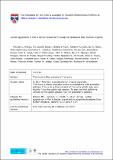Files in this item
Lethal aggression in Pan is better explained by adaptive strategies than human impacts
Item metadata
| dc.contributor.author | Wilson, Michael L. | |
| dc.contributor.author | Boesch, Christophe | |
| dc.contributor.author | Fruth, Barbara | |
| dc.contributor.author | Furuichi, Takeshi | |
| dc.contributor.author | Gilby, Ian C. | |
| dc.contributor.author | Hashimoto, Chie | |
| dc.contributor.author | Hobaiter, Cat | |
| dc.contributor.author | Hohmann, Gottfried | |
| dc.contributor.author | Itoh, Noriko | |
| dc.contributor.author | Koops, Kathelijne | |
| dc.contributor.author | Lloyd, Julia N. | |
| dc.contributor.author | Matsuzawa, Tetsuro | |
| dc.contributor.author | Mitani, John C. | |
| dc.contributor.author | Mjungu, Deus C. | |
| dc.contributor.author | Morgan, David | |
| dc.contributor.author | Muller, Martin N. | |
| dc.contributor.author | Mundry, Roger | |
| dc.contributor.author | Nakamura, Michio | |
| dc.contributor.author | Pruetz, Jill | |
| dc.contributor.author | Pusey, Anne E. | |
| dc.contributor.author | Riedel, Julia | |
| dc.contributor.author | Sanz, Crickette | |
| dc.contributor.author | Schel, Anne Marijke | |
| dc.contributor.author | Simmons, Nicole | |
| dc.contributor.author | Waller, Michel | |
| dc.contributor.author | Watts, David P. | |
| dc.contributor.author | White, Frances | |
| dc.contributor.author | Wittig, Roman Martin | |
| dc.contributor.author | Zuberbuehler, Klaus | |
| dc.contributor.author | Wrangham, Richard W. | |
| dc.date.accessioned | 2015-03-18T00:01:35Z | |
| dc.date.available | 2015-03-18T00:01:35Z | |
| dc.date.issued | 2014-09-18 | |
| dc.identifier | 149553847 | |
| dc.identifier | f39665b1-3cc7-4772-9515-4759e6ab5ffa | |
| dc.identifier | 84907762429 | |
| dc.identifier | 000341814900059 | |
| dc.identifier.citation | Wilson , M L , Boesch , C , Fruth , B , Furuichi , T , Gilby , I C , Hashimoto , C , Hobaiter , C , Hohmann , G , Itoh , N , Koops , K , Lloyd , J N , Matsuzawa , T , Mitani , J C , Mjungu , D C , Morgan , D , Muller , M N , Mundry , R , Nakamura , M , Pruetz , J , Pusey , A E , Riedel , J , Sanz , C , Schel , A M , Simmons , N , Waller , M , Watts , D P , White , F , Wittig , R M , Zuberbuehler , K & Wrangham , R W 2014 , ' Lethal aggression in Pan is better explained by adaptive strategies than human impacts ' , Nature , vol. 513 , no. 7518 , pp. 414-417 . https://doi.org/10.1038/nature13727 | en |
| dc.identifier.issn | 0028-0836 | |
| dc.identifier.other | ORCID: /0000-0002-3893-0524/work/46125071 | |
| dc.identifier.other | ORCID: /0000-0001-8378-088X/work/64360776 | |
| dc.identifier.uri | https://hdl.handle.net/10023/6258 | |
| dc.description | This study was funded by National Science Foundation grants BCS-0648481 and LTREB-1052693 and National Institutes of Health grant R01 AI 058715. | en |
| dc.description.abstract | Observations of chimpanzees (Pan troglodytes) and bonobos (Pan paniscus) provide valuable comparative data for understanding the significance of conspecific killing. Two kinds of hypothesis have been proposed. Lethal violence is sometimes concluded to be the result of adaptive strategies, such that killers ultimately gain fitness benefits by increasing their access to resources such as food or mates1,2,3,4,5. Alternatively, it could be a non-adaptive result of human impacts, such as habitat change or food provisioning6,7,8,9. To discriminate between these hypotheses we compiled information from 18 chimpanzee communities and 4 bonobo communities studied over five decades. Our data include 152 killings (n = 58 observed, 41 inferred, and 53 suspected killings) by chimpanzees in 15 communities and one suspected killing by bonobos. We found that males were the most frequent attackers (92% of participants) and victims (73%); most killings (66%) involved intercommunity attacks; and attackers greatly outnumbered their victims (median 8:1 ratio). Variation in killing rates was unrelated to measures of human impacts. Our results are compatible with previously proposed adaptive explanations for killing by chimpanzees, whereas the human impact hypothesis is not supported. | |
| dc.format.extent | 4 | |
| dc.format.extent | 470420 | |
| dc.language.iso | eng | |
| dc.relation.ispartof | Nature | en |
| dc.subject | QH301 Biology | en |
| dc.subject | BF Psychology | en |
| dc.subject | BDC | en |
| dc.subject | R2C | en |
| dc.subject | ~DC~ | en |
| dc.subject | SDG 16 - Peace, Justice and Strong Institutions | en |
| dc.subject.lcc | QH301 | en |
| dc.subject.lcc | BF | en |
| dc.title | Lethal aggression in Pan is better explained by adaptive strategies than human impacts | en |
| dc.type | Journal item | en |
| dc.contributor.institution | University of St Andrews. School of Psychology and Neuroscience | en |
| dc.contributor.institution | University of St Andrews. Centre for Social Learning & Cognitive Evolution | en |
| dc.contributor.institution | University of St Andrews. Institute of Behavioural and Neural Sciences | en |
| dc.identifier.doi | 10.1038/nature13727 | |
| dc.description.status | Peer reviewed | en |
| dc.date.embargoedUntil | 2015-03-18 |
This item appears in the following Collection(s)
Items in the St Andrews Research Repository are protected by copyright, with all rights reserved, unless otherwise indicated.

